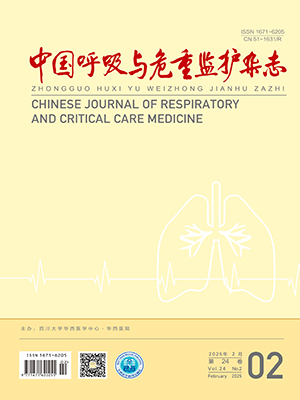| 1. |
Sopena N, Heras E, Casas I, et al. Risk factors for hospital-acquired pneumonia outside the intensive care unit: a case-control study. Am J Infect Control, 2014, 42(1): 38-42.
|
| 2. |
阮海燕, 周兴辉, 曹奇峰. 医院获得性肺炎的病原学分布及危险因素分析. 中华医院感染学杂志, 2011, 21(18): 3957-3959.
|
| 3. |
史建梅. 医院获得性肺炎危险因素分析及护理措施. 中国医药指南, 2013,11 (10): 710-711.
|
| 4. |
American Thoracic Society Documents, Guidelines for the management of adults with hospital-acquired, ventilator-associated, and healthcare-associated pneumonia. Am J Respir Crit Care Med, 2005, 171(4): 388-416.
|
| 5. |
Thompson DA, Makary MA, Dorman T, et al. Clinical and economic outcomes of hospital acquired pneumonia in intra-abdominal surgery patients. Ann Surg, 2006, 243(4): 547-552.
|
| 6. |
金珍. 医院获得性肺炎危险因素及用药分析. 中华医院感染学志, 2012,22 (20): 4467-4468.
|
| 7. |
侯爱红. 医院获得性肺炎危险因素分析. 中华医院感染学杂志, 2002, 12(10): 742-743.
|
| 8. |
李雅立. 医院获得性肺炎的危险因素分析及干预措施. 中国误诊学杂志, 2011,11(23): 5645-5646.
|
| 9. |
龙定梅. 医院获得性肺炎的危险因素及病原菌分布. 临床肺科杂志, 2012,17 (12): 2275-2276.
|
| 10. |
Dulhunty JM, Webb SA, Paterson DL, et al. A survey of antibiotic prescribing practices in Australian and New Zealand intensive care units. Crit Care Resusc, 2010, 12(3): 162-170.
|
| 11. |
Vanhems P, Bénet T, Voirin N, et al. Early-onset ventilator-associated pneumonia incidence in intensive care units: [ a surveillance-based ] study. BMC Infect Dis, 2011, 11: 236.
|
| 12. |
Herzig SJ, Howell MD, Ngo LH, et al. Acid-suppressive medication use and the risk for hospital-acquired pneumonia. JAMA, 2009, 301(20): 2120-2128.
|
| 13. |
Chung DR, Song JH, Kim SH, et al. High prevalence of multidrug-resistant nonfermenters in hospital-acquired pneumonia in Asia. Am J Respir Crit Care Med, 2011, 184(12): 1409-1417.
|
| 14. |
施晓群, 孙景勇, 倪语星, 等. 2011 年中国 C H INET 铜绿假单胞菌耐药性监测. 中国感染与化疗杂志, 2013, 13(3): 218-221.
|
| 15. |
李茉莉, 潘频华, 胡成平. 呼吸 ICU 医院获得性肺炎的病原菌分布与致病菌耐药性的变迁.中南大学学报(医学版), 2013, 38(3): 251-257.
|
| 16. |
唐贞明, 凌宙贵, 刘卫, 等. 医院与社区获得性肺炎的病原菌分布及耐药性. 中华医院感染学杂志, 2014, 24(5): 1092-1094.
|
| 17. |
Fagon JY, Chastre J, Wolff M, et al. Invasive and noninvasive strategies for management of suspected ventilator-associated pneumonia. A randomized trial. Ann Intern Med, 2000, 132(8): 621-630.
|




